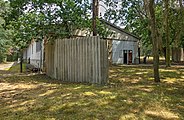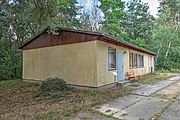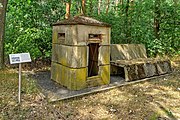Lübschützer Teiche Stasi Bunker

The Lübschützer Teiche Bunker Complex, built 1968–1972, was designed to be an emergency command centre for the District Administration for State Security, Leipzig (part of the Ministry for State Security, also known as the Stasi) in the event of war or a nuclear attack. It was never used for its intended purpose.
Location and structure[edit]

The facility is about 20 km (12.4 mi) east of Leipzig and about 3 km (1.9 mi) north of Machern. It is located at the northeast end of the "Lübschützer Teiche e.V." recreational area and was disguised as a holiday complex belonging to "VEB Water Supply and Sewage Treatment Leipzig".[1]
The total area of the site is 5.2 ha (12.8 acres). The bunker buildings are approximately 15,000 m2 (161,458.7 sq ft).
The entire area was divided into an inner and an outer security zone and surrounded with chain-link fencing. The fences further divided the facility into three outer areas: north, east, and south.[2] The commandant's bungalow was located in the south area, near the southern entrance.[3] The east area had three bungalows, the middle of which was used by the commandant's deputy in his absence. These bungalows also served to disguise the grounds as a company holiday complex.[4] Only specially qualified Stasi employees had access to the inner zone in which the actual bunker was located.[2] The site was secured by a commandant at the rank of major, his deputy, and about six guards, as well as several dogs.
Construction and camouflage of the camp[edit]


The complex was designed for 100-120 full-time employees. The bunker itself was made of reinforced concrete and measured 35 m (114.8 ft) x 41 m (134.5 ft), at a depth of about 5 m (16.4 ft) to 6 m (19.7 ft). It was covered by about 2.5 m (8.2 ft) of earth. Access was by two staircases, one on the east side and one on the west, that could be closed off by solid panels. The "legending hall", a dummy building meant to disguise the entrance of the bunker, had two large wooden doors and was made of lightweight construction so that the bunker entrances would not be buried if the building was destroyed. The bunker contained working and sleeping rooms, sanitary facilities, a kitchen, and an infirmary, and had air filters, communications equipment, and emergency power generators with tanks for about 6000 litres of diesel fuel. The 16 total rooms were arranged in two rows of eight, with each room measuring approximately 2 m (6.6 ft) x 14 m (45.9 ft).[5][6]
For radio communication, a transmitter was hidden in a smaller bunker about 3 km (1.9 mi) to the west, in Tresenwald near Gerichshain. This transmitter was placed there to prevent enemy reconnaissance from using radio direction finding to locate the main bunker complex. It was camouflaged with two bungalows, which were supposedly a vacation property of the Council of the District of Leipzig, and could be remotely operated from the main bunker. In case the remote transmitter was destroyed, the complex maintained an emergency transmitter in the bunker itself with an antenna on the grounds.[7]
There were some redundant systems in the complex, such as the water supply and the radio. This was intended to ensure functionality for about a week in the event of an emergency, so that, for example, the suppression of a popular uprising could be directed from the site.
Since the facility was built under strict secrecy, no civilian employees were allowed on the site. The only exception was for the construction of two wells in the inner zone, which were drilled by a civilian company before the bunker was built in 1968, since the Stasi did not have the necessary specialists.[8] All other work was done by the Stasi employees themselves. For this purpose the complex contained a carpentry shop[9] and an electrical workshop,[10] and there was a locksmith's in the main building.[11] These outbuildings, along with a garage complex[12] and a dog kennel,[13] served to camouflage the bunker, which had no outer zone to the west to hide it. In addition, privacy fencing was placed at the west entrance of the "legending hall".[14] The main function of this building was to camouflage the bunker from western satellite reconnaissance. It was also used to store mobilization reserves.[11] Both entrances to the building were secured by a guard dog on a dog run.[15][5][6]
Discovery and current use[edit]
The bunker was not discovered until December 1989. Today, the site is part of the "Runde Ecke" Memorial Museum in Leipzig and is operated by the Citizens' Committee. Visitors can see the preserved buildings and the interior furnishings, some of which are original and some of which were sourced from other Stasi bunkers. This includes some of the period communications technology, but not the encryption technology, which was dismantled by Soviet officers.[16] In 1995, the Citizens' Committee succeeded in attaining historical monument protection status for the entire complex.
There are several accompanying exhibitions on the site. For example, near the south entrance, next to the commandant's house, are 11 information boards commemorating the Peaceful Revolution of 1989. There are about 30 weather-resistant information boards permanently installed on the site that explain the function of individual buildings and facilities. Guided group tours are provided, and the outdoor facilities are available for self-directed visits during opening hours.
Gallery[edit]
-
Main entrance on the south side of the site
-
Commandant's bungalow near the south entrance
-
"Legending hall" from the west, with privacy fencing
-
Social building and electrical workshop north of the main hall
-
Carpentry workshop, south of the main building
-
Bungalow in the outer zone, which among other purposes served as camouflage
-
Combat posts were built to secure access in the event of an emergency
-
West entrance of the bunker
-
One of the workrooms
-
Sleeping room with 24 beds
-
The then state-of-the-art teleprinters
References[edit]
- ^ "Museum in der "Runden Ecke" mit dem Museum im Stasi-Bunker. Bürgerkomitee Leipzig e.V.: Stasi Bunker Museum". www.runde-ecke-leipzig.de. Retrieved 2021-12-30.
- ^ a b Museum information panels 4 and 12: "Gate to 'Zone I' (exclusion zone)"
- ^ Museum information panel 2: "Bunker commandant's house"
- ^ Museum information panel 14: "Bungalows"
- ^ a b "DDR-Vergangenheit im Stasi-Bunker Machern erleben". LVZ - Leipziger Volkszeitung (in German). Retrieved 2021-12-30.
- ^ a b Kellerhoff, Sven Felix (2011-09-09). "Dritter Weltkrieg: Der Bunker, in dem die Stasi dem Atomkrieg trotzte". DIE WELT (in German). Retrieved 2021-12-30.
- ^ Museum information panel 19: "Polarization antenna"
- ^ Museum information panel 25: "Well shaft"
- ^ Museum information panel 26: "Carpenter's shop"
- ^ Museum information panel 9: "Social building and electrical workshop"
- ^ a b Museum information panel 30: "'Legending hall' with locksmith's workshop"
- ^ Museum information panel 7: "Garage complex with shed roof"
- ^ Museum information panel 8: "Dog kennel"
- ^ Museum information panel 10: "Privacy fences"
- ^ Museum information panels 11 and 29: "Dog runs"
- ^ Aberger, Jörg (2006-10-09). "DDR-Bunker Machern: Das Versteck der Stasi". Der Spiegel (in German). ISSN 2195-1349. Retrieved 2022-01-01.
External links[edit]
Further reading[edit]
"Neues Besucherzentrum am Stasi-Bunker Machern eröffnet". Mitteldeutscher Rundfunk. January 10, 2020. Archived from the original on January 11, 2020. Retrieved January 1, 2022.











